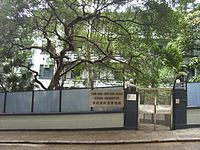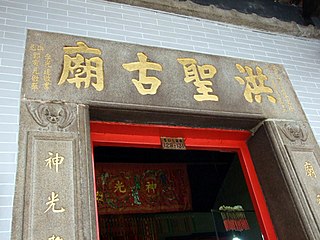Historic police stations
Historic police stations include:
| Name | Photographs | Location | Notes/References |
|---|---|---|---|
| Old Stanley Police Station |  | 22°13′06″N114°12′47″E / 22.21831°N 114.213121°E | Built in 1859, a declared monument. Now used as a Wellcome supermarket. |
| Central Police Station |  | 22°16′54″N114°09′15″E / 22.28174°N 114.154196°E | Built in 1864, a declared monument |
| Former Marine Police Headquarters Compound |  | 22°17′44″N114°10′12″E / 22.295479°N 114.169994°E | Built in 1884. Now a heritage hotel with food and beverage outlets, and retail facilities. A declared monument. |
| Peak Police Station | No. 92 Peak Road, The Peak. | Built in 1886. A Grade III Historic Building. | |
| Old Aberdeen Police Station |  | No. 116 Aberdeen Main Road, Aberdeen. | Built in 1891. A Grade II Historic Building. |
| Old Tai Po Police Station |  | 22°26′47″N114°10′11″E / 22.446422°N 114.169735°E | Built in 1899. A declared monument. |
| Old Ping Shan Police Station |  | 22°26′47″N114°10′11″E / 22.446422°N 114.169735°E | Built in 1899. Now used as the Ping Shan Tang Clan Gallery cum Heritage Trail Visitors Centre. A Grade II Historic Building. |
| Former Tiu Keng Leng Police Station aka. Rennie's Mill Police Station (舊調景嶺警署) |  | No. 160 Po Lam Road South, Tiu Keng Leng | Built in 1900. Closed in 1941. Since 1999, it was partially used by the Po Yin Fat Yuen, a monastery founded in 1956, after the original monastery building was torn down with the clearance of the nearby squatter area in 1996. Its function as a monastery ceased in 2015. [1] |
| Old Tai O Police Station |  | 22°15′12″N113°51′13″E / 22.25322°N 113.853686°E | Built in 1902, a Grade III Historic Building. Converted into a boutique hotel. |
| Old Sheung Shui Police Station (舊上水警署) |  | 22°30′30″N114°07′32″E / 22.508248°N 114.125432°E | Built in 1902. Now housing a Junior Police Corps (JPC) Club House. It is a Grade III historic building. |
| Cheung Chau Police Station (長洲警署) |  | No. 4 Police Station Path, Cheung Chau. | Built in 1913. A Grade II Historic Building. Still used as a police station. |
| Lok Ma Chau Police Station |  | No. 100 Lok Ma Chau Road, Lok Ma Chau. | Built in 1915. A Grade II Historic Building. Still used as a police station. |
| Yau Ma Tei Police Station |  | 22°18′35″N114°10′07″E / 22.309676°N 114.168704°E | Built in 1922, a Grade III Historic Building, closed and relocated in 2016 |
| Sham Shui Po Police Station |  | 22°19′48″N114°09′33″E / 22.329986°N 114.159088°E | Built in 1924, a Grade III Historic Building |
| Former Sha Tin Police Station |  | No. 102 Sha Tin Tau Village | Built around 1924. Converted into the High Rock Christian Camp in 1980. [2] A Grade II Historic Building. |
| Old Kowloon Police Headquarters (舊九龍警察總部) |  | 22°19′28″N114°10′08″E / 22.324525°N 114.168835°E | Built in 1925. Now part of the Mong Kok Police Station. Grade II Historic Building. [3] |
| Wan Chai Police Station |  | 22°16′45″N114°10′31″E / 22.279248°N 114.175286°E | Built in 1932. A Grade III Historic Building. |
| Old Upper Levels Police Station |  | No. 1F High Street, Sai Ying Pun. | Built in 1934-1935. It was later used as the Crime Hong Kong Island Regional Headquarters. Now part of the David Trench Rehabilitation Centre. A Grade III Historic Building. |
| Ta Kwu Ling Police Station |  | Ping Che Road, Ta Kwu Ling. | Built in 1937. Still used as a police station. A Grade III Historic Building. |
| Former Wan Chai Gap Police Station |  | 22°16′04″N114°10′09″E / 22.26765°N 114.169197°E | Built in 1939. Now housing the Hong Kong Police Museum. |
| Former Lau Fau Shan Police Station |  | Lau Fau Shan. 22°28′09″N113°59′02″E / 22.469035°N 113.983795°E | Built in 1962. Used until 2002. [4] Awaiting adaptive reuse. It has been proposed to be converted into a restaurant with exhibition space to reminisce the history of the oyster farming industry of Lau Fau Shan. [5] A Grade III Historic Building. |



















